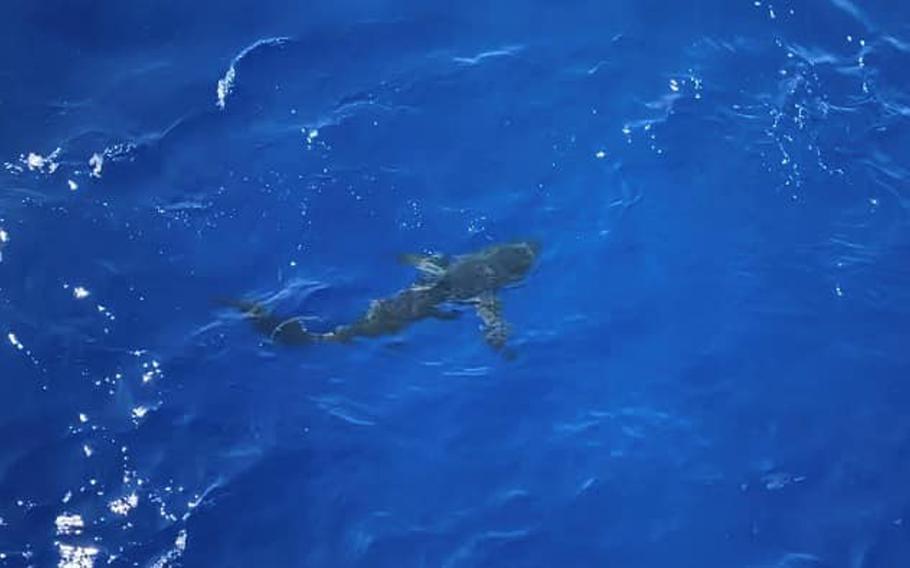
A shark interrupted a U.S. Coast Guard swim call, somewhere in Oceania, Aug. 21, 2020, prompting an overwatch to fire into the water to scare it away. The Coast Guard said they were well-aimed shots and they didn't hurt any of the nearby swimmers, including the shark. (Facebook/U.S. Coast Guard Cutter Kimball)
A Coast Guard swim call in the Pacific Ocean nearly turned into a scene from “Jaws” when a shark tried to join the party, according to harrowing video the service published recently.
The crew had finished their operations somewhere in Oceania on Aug. 21 and had not been off the ship for weeks when they decided to have the swim call, the U.S. Coast Guard cutter Kimball said in a Facebook post.
“There were no vessels around for miles, the weather was perfect and we were a zillion miles from land,” the post said. “[We] were at that point where every day feels like ‘Groundhog Day’ and were looking for something to break up the monotony.”
A shark appeared to be happy to spice up the day for the approximately 40 Kimball crewmembers swimming within 50 yards of the cutter, according to the post.
The uninvited guest was between 6 and 8 feet long, the Coast Guard said in the caption of a video of the encounter.
It was likely a blue shark or a silky shark, said biologist Gavin Naylor, director of the Florida Program for Shark Research. It might have been a more dangerous, critically endangered oceanic whitetip, he said, but he couldn’t tell if it had characteristic white-tipped fins.
Blue and silky sharks can be dangerous, but the oceanic whitetip “should be treated with extreme caution,” says the shark research program’s site. The species shows little fear around divers and tends to circle persistently.
Often first on the scene of mid-ocean disasters, it was a “major concern” for torpedoed boats and downed planes during both World Wars, the site says, and is the main species implicated in attacking the survivors of the USS Indianapolis in 1945, “the ‘worst shark attack in history.’”
Still, unprovoked attacks are relatively rare — there were 64 worldwide in 2019 — and result in an average of about four fatalities a year, according to Naylor’s research program at the Florida Museum of Natural History in Gainesville, which maintains a database of over 6,500 incidents since the 1500s.
Curious sea life often like to check out anything floating on the surface in the sparsely populated open ocean, Naylor said in an email Thursday.
“It’s not clear from the video whether the shark was posing a threat ... primarily because I cannot make out the (shark’s) movements,” he said.
The footage shows Petty Officer 1st Class Samuel Cintron, a maritime enforcement specialist aboard the Kimball, shooting at the shark as it circled the cutter and approached the swimmers. The shark briefly turned away after each round of shots but kept circling back.
“Our goal was to keep [the shark] away from shipmates, not harm it, if possible. It was most likely curious and not looking for a meal,” the Facebook post said. “We picked our location to try and avoid such an encounter, but it is their ocean after all.”
It's common to post a gunner’s mate armed with an M1 or M14 rifle as a “shark watch” aboard Navy vessels during search and rescue operations. Navy instructions state that the sailor should “fire to drive off a shark only as a last resort and when directed.”
It’s unclear how often they’re called upon to actually do so or how effective it is — bullets don’t typically travel very far after they strike water due to drag. Neither the Navy nor the Coast Guard responded to Stars and Stripes queries about such incidents.
“Shooting rounds into the water would not help increase the safety of the men in the water,” Naylor said.
Between the sounds of gunfire in the video, reggae music played in the background as swimsuit-clad service members aboard the cutter shouted orders and kept their eyes on the shark.
“Heading toward the bow! Heading toward the bow!” a crewmember called out. “Port side, port side!” Cautiously, the swimmers made their way to a small rescue boat as the shark swam nearby. Others climbed a rope ladder hanging off the side of the cutter.
Luckily, there were no casualties. All the swimmers safely made their way back onto the cutter, and “the shark appeared uninjured as it swam away,” the video caption says. Even a unicorn-shaped pool floaty that was ditched in the hustle to get aboard the rescue vessel was saved.
The Kimball post called the shark encounter “one of the most amazing events many of us have ever experienced at sea.”
“It wasn’t the panic of the 4th of July scene from ‘Jaws,’ but once everyone realized what was happening, they moved with a purpose!” the post said.
That was an appropriate response, Naylor said.
“The Coast Guard did the right thing in getting the men out of the water,” he said. Later, he added: “P.S. I really like the inflatable unicorn!”